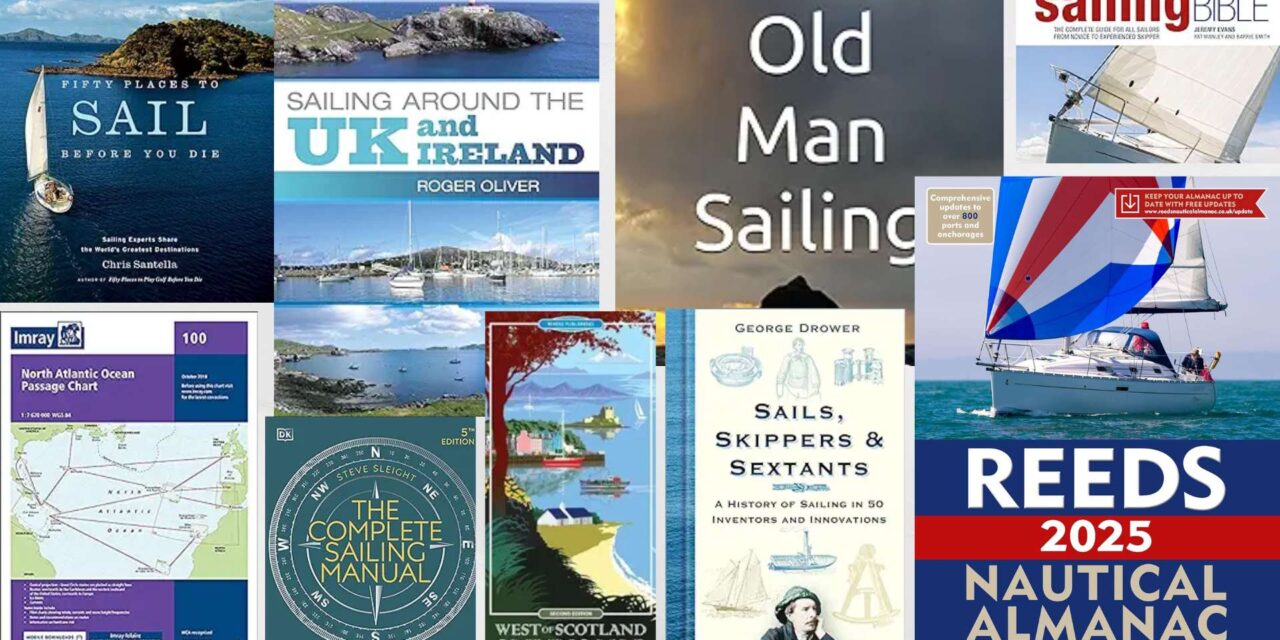Best Books About Sea for Every Aspiring Mariner
If you’re an aspiring mariner, you know that mastering the art of sailing requires more than just practice on the water. The right books can be invaluable tools, offering both foundational knowledge and advanced techniques. We’ve curated a list of the 11 best books about sailing that cater to all levels, from ‘Sailing For Dummies’ for beginners to ‘Expert Sailing Skills’ for seasoned sailors. Each book serves a unique purpose, whether it’s teaching you the basics or helping you navigate complex maritime challenges. Curious about which titles made the cut and why they’re essential for your journey?
Sailing For Dummies, 3rd Edition
“Sailing For Dummies, 3rd Edition, is perfect for aspiring mariners looking for a well-written, easy-to-read guide that covers everything from docking to racing. You’ll find the instructions clear and straightforward, with limited nautical jargon to keep things simple.
The book is filled with helpful tips and cautionary notes to make sure you avoid common pitfalls. Whether you’re new to sailing or just need a refresher, this guide builds your confidence by covering most scenarios you might encounter on the water.
With over 60 years of sailing and racing experience, the authors know their stuff. It’s so well-regarded that it’s even required reading for sailing camp counselors in training. If you’re looking to start your sailing journey, this book is a must-have.”
Best For: Aspiring sailors looking for a comprehensive and easy-to-read guide to learn or refresh their sailing skills.
Pros: – Well written and thorough with clear instructions. – Limited use of nautical terms, making it easy to understand. – Filled with helpful tips and cautionary notes.
Cons: – May not cover highly advanced or specialized sailing techniques. – Some experienced sailors might find the basics overly simplistic. – Physical copy could be bulky for on-the-go reference.
The Sailing Handbook: A Complete Guide for Beginners
The Sailing Handbook: A Complete Guide for Beginners is perfect for novices looking to grasp both basic principles and advanced topics in sailing. This manual has received positive reviews for its fantastic illustrations, making complex concepts easier to understand. You’ll find it particularly helpful as it covers most aspects of the subject, from the basics to more advanced ideas. Reviewers appreciate its clear descriptions that match the content, providing a solid start for any new sailor.
However, some readers feel it’s a bit general and could offer more detail on specific areas like sailing and docking. Despite this, it’s an enjoyable read that brings the experience of yachting to your living room. Overall, it delivers exactly what it promises.
Best For: Novices looking to understand both basic and advanced principles of sailing.
Pros: – Fantastic illustrations that simplify complex concepts. – Covers a wide range of topics from basic to advanced. – Clear descriptions that match the content.
Cons: – Some find it too general in certain areas. – Lacks detailed information on sailing and docking. – Could be more comprehensive on specific topics.
The Complete Sailing Manual
Aspiring mariners will find ‘The Complete Sailing Manual’ an indispensable guide, whether you’re just starting out or looking to deepen your sailing expertise. This book is beautifully laid out with illustrations that make intricate information easy to understand. It’s praised for its all-encompassing coverage, making it a valuable resource from novice to seasoned sailor.
The content is clearly presented, ensuring that you can grasp essential sailing concepts effortlessly. Available in both hardcover and softcover, the book’s robust, embossed finish adds to its appeal. Ideal for RYA courses or as a thoughtful gift, ‘The Complete Sailing Manual’ offers great value with its extensive sailing content.
Positive feedback in multiple languages attests to its global appeal and usefulness.
Best For: Aspiring mariners, from complete novices to experienced sailors, looking for a comprehensive and beautifully presented sailing guide.
Pros: – Comprehensive coverage of sailing topics – Beautifully laid out with clear illustrations – Suitable for both beginners and seasoned sailors
Cons: – Some copies may arrive slightly damaged – Hardcover option may be bulkier to handle – Limited availability in certain languages
Sails, Skippers and Sextants: A History of Sailing
If you’re a boating enthusiast looking for a blend of historical facts and navigational innovations, ‘Sails, Skippers and Sextants: A History of Sailing’ is an engaging read.
The book dives deep into traditional sailboats and maritime safety, offering insights into the inventions that have shaped nautical navigation. Though it places a stronger emphasis on yachts, the historical anecdotes remain enthralling.
Reviews highlight it as ideal for fireside reading, fun and informative, and a great gift for sailors. However, some readers found the content disappointingly Brit-centric, and there were mixed opinions about its overall appeal.
Despite these criticisms, it’s recommended for those passionate about sailing, providing a detailed and informative look at the history of sailing.
Best For: Boating enthusiasts and anyone interested in the history and innovations of sailing.
Pros: – Contains fascinating historical facts about traditional sailboats and maritime safety. – Offers insights into navigational innovations that have shaped the sailing world. – Ideal as a gift for sailors and boating enthusiasts, providing informative content.
Cons: – Some readers found the content to be Brit-centric. – Focuses more on yachts than sailing vessels in general. – Mixed opinions on overall appeal, with some readers feeling disappointed.
Expert Sailing Skills – No Nonsense Advice That Really Works
Access expert sailing tips with ‘Expert Sailing Skills – No Nonsense Advice That Really Works,’ ideal for intermediate to experienced sailors seeking practical guidance and clear illustrations.
This lively book, praised for its pithy delivery and clear photographs, provides thorough advice that’s both informative and entertaining. While some find the nautical terms challenging, the content is highly recommended for cruising skippers and sailing enthusiasts alike.
Readers often revisit this standout resource to handle sailboats in various circumstances. Though not suited for complete novices, experienced sailors can benefit greatly from the book’s extensive coverage of sailing topics and common scenarios.
If you subscribe to Yachting Monthly, you’ll particularly appreciate the author’s expertise. Add this must-have guide to your maritime library today.
Best For: Intermediate to experienced sailors looking for practical advice and clear illustrations to enhance their sailing skills.
Pros: – Lively book with great illustrations and pithy delivery. – Highly recommended for cruising skippers and sailing enthusiasts. – Provides thorough and practical advice for various sailing scenarios.
Cons: – Challenging for beginners due to complex nautical terminology. – Not suited for complete novices. – Some readers may struggle with the nautical terms despite the clear photographs.
Amazing Sailing Stories – True Adventures from the High Seas
Dick Durham’s ‘Amazing Sailing Stories – True Adventures from the High Seas’ is perfect for those who crave thrilling, real-life nautical adventures. This collection offers you a range of gripping tales, from tragic expeditions to epic journeys.
You’ll find stories about shipwrecks, murder on board, cannibalism, and treasure hunts. While some readers note the writing style is factual and less dramatic, the clear accounts still capture the essence of each adventure.
The brevity of the stories might leave you wanting more details, but the included bibliography offers further reading. This book is ideal for quick reads or for dipping into short, engaging stories.
If you love survival, luck, and danger at sea, this one’s for you.
Best For: Those who love thrilling, real-life nautical adventures, survival stories, and quick, engaging reads.
Pros: – A wide range of gripping and fascinating nautical tales. – Clear accounts of each adventure, despite a factual writing style. – Includes a bibliography for further reading on specific stories.
Cons: – The brevity of the stories may leave some readers wanting more details. – The factual writing style may lack dramatic flair for some readers. – Each tale could potentially be expanded into a full-length book.
Where the Wind Blows: A Family’s Sailing Adventure in the Mediterranean
For aspiring mariners who are keen to explore family dynamics and personal growth through sailing, ‘Where the Wind Blows: A Family’s One Year Escape from Routine Life to A Sailing Adventure in the Mediterranean’ offers an engaging mix of adventure, challenges, and humor.
Set in the late 1980s, Heyward Coleman and his family set out on a year-long voyage, giving you a snapshot of Mediterranean cruising in a bygone era. The book’s vivid descriptions of places and personal anecdotes make it relatable, whether you’re an experienced sailor or an armchair adventurer.
You’ll appreciate the family’s planning, the author’s patient approach to challenges, and the evolving navigation tools. This story highlights family resilience and bonding, making it a must-read for any sailing enthusiast.
Best For: Aspiring mariners and armchair adventurers interested in family dynamics and personal growth through a Mediterranean sailing experience.
Pros: – Vivid descriptions of Mediterranean locations and sailing experiences. – Insightful personal anecdotes and family bonding moments. – Valuable advice on planning and navigating a sailing journey.
Cons: – Some readers may find the narrative lacks liveliness or emotional connection. – The setting and technology described may feel outdated to modern sailors. – The pacing might be slow for those seeking constant high-energy adventure.
In the Wake of Heroes: Sailings Greatest Stories Introduced by Tom Cunliffe
In the Wake of Heroes: Sailings Greatest Stories, introduced by Tom Cunliffe, is an ideal read for aspiring mariners seeking both entertainment and education through a well-curated collection of sailing tales.
Tom and his wife, Ros, have selected a diverse range of punchy stories that cover themes like Classic Yachting and Voyages Under Duress. Each story is accompanied by Tom’s brief, engaging introductions, making it enjoyable and informative.
Readers appreciate discovering new books and authors through these excerpts. While one critique mentions that some stories may lose impact in translation, most find it a valuable and pleasurable read.
Perfect for out-of-season reading with a glass of rum, this book is highly recommended for anyone interested in sailing.
Best For: Aspiring mariners and sailing enthusiasts looking for both entertainment and educational insights through a well-curated collection of stories.
Pros: – Diverse range of punchy sailing stories with engaging introductions. – Covers various themes like Classic Yachting and Voyages Under Duress. – Leads readers to discover new books and authors in sailing literature.
Cons: – Some stories may lose impact in translation. – The storytelling style may be subjective to individual tastes. – Not ideal for readers uninterested in maritime themes.
Fifty Places to Sail Before You Die
Aspiring mariners will find ‘Fifty Places to Sail Before You Die’ an engaging guide filled with alluring destinations and practical insights. This book is a treasure trove for those passionate about sailing, offering a mix of popular and lesser-known spots.
While the content can be US-centric, with 18 locations in the US and another 6 nearby, it still promises to spark your wanderlust. Readers have praised it as an excellent gift, rich with good descriptions and beautiful pictures. However, some reviews note the articles are brief and the photos stock-like.
Despite these critiques, it remains a valuable resource that can inspire your next sailing adventure, making it a worthwhile addition to your maritime library.
Best For: Aspiring sailors and maritime enthusiasts looking for inspiration and practical insights into sailing destinations.
Pros: – Engaging guide with a mix of popular and lesser-known sailing spots. – Excellent gift choice praised for its good descriptions and beautiful pictures. – Sparks wanderlust and inspires future sailing adventures.
Cons: – Content is very US-centric, with a significant number of locations in the US and nearby. – Articles are brief and lack depth, often using stock photos. – Some copies may arrive with a well-worn cover not mentioned in the description.
Yachting Monthlys Confessions: Yachtsmen Own Up to Their Sailing Sins
Yachting Monthly’s Confessions offers a humorous and relatable collection of tales perfect for any sailor who’s made their share of mistakes on the water. Readers rave about its ability to turn even the most embarrassing gaffes into laugh-out-loud moments.
You’ll find yourself chuckling along with the stories, feeling a sense of camaraderie with fellow sailors. Illustrated by the brilliant Mike Peyton, the book’s cartoons add an extra layer of enjoyment.
Though some found it smaller than expected, the witty, instructive content makes it a hit. Many reviewers highlight its value as a gift, mentioning how their sailing partners couldn’t put it down.
For any proper yachter, this book is both a hilarious and comforting read.
Best For: Sailors and yachting enthusiasts looking for a humorous and relatable read.
Pros: – Hilarious and believable stories that resonate with sailors. – Brilliant illustrations by Mike Peyton enhance the reading experience. – Highly appreciated as a gift for sailing enthusiasts.
Cons: – Some readers found the book smaller than expected. – Content may not appeal to motor boating enthusiasts. – Limited to those who enjoy sailing-related humor and anecdotes.
The Book of Tides
If you’re a coastal enthusiast looking to deepen your understanding of tides, waves, and moon phases, ‘The Book of Tides’ offers a concise yet thorough resource that’s both informative and engaging.
Packed with amazing facts and helpful for various water activities, this book is a treasure trove of knowledge. It’s praised for its impressive format, sharp illustrations, and engrossing content, making it a good read for swimmers and sea enthusiasts alike.
Despite minor criticisms about the Kindle version’s poor digitization, the book remains a favorite, quickly delivered and often bought as a gift. Readers appreciate its simplicity and clarity, making complex topics accessible.
Whether you’re fascinated by the moon’s influence on tides or preparing for a day at sea, this book is indispensable.
Best For: Coastal enthusiasts and water sports lovers who want an engaging and informative resource on tides, waves, and moon phases.
Pros: – Packed with amazing facts and information. – Impressive format, sharp illustrations, and clear content. – Helpful for various water activities and potentially life-saving.
Cons: – Poor digitization of the Kindle version. – Text difficult to read due to formatting issues. – Minor criticisms despite being a good read.
Factors to Consider When Choosing Books About Sailing
When choosing books about sailing, consider the author’s sailing expertise and verify they’ve hands-on experience.
Think about whether the book is aimed at beginners or seasoned sailors to match your skill level.
Also, look for a balance between practical advice, theoretical insights, and whether the book includes helpful illustrations and photos.
Author’s Sailing Expertise
To choose the best sailing books, prioritize authors with extensive hands-on experience and recognized qualifications. You want someone who’s been out on the water, faced diverse conditions, and navigated different environments. Practical knowledge is invaluable, and authors who’ve sailed extensively offer a depth of understanding that’s difficult to match.
Look for authors with certifications, teaching experience, or long careers in sailing. These credentials often indicate that the author not only understands sailing theoretically but also knows how to communicate complex concepts effectively. A seasoned sailor who’s taught others can provide insights and practical tips that are crucial for your learning journey.
To verify an author’s sailing background, check their bio, acknowledgments, or foreword. These sections usually offer glimpses into their experience and qualifications. You could also look for mentions of specific sailing achievements, such as long voyages, races, or time spent teaching sailing courses. This information helps gauge their credibility and confirms the content you’re reading comes from a knowledgeable and reliable source.
Target Audience Demographics
Choosing the right sailing book involves considering the reader’s age, experience level, and specific interests within the world of sailing. You’ll want to match the book’s importance with the reader’s knowledge. Beginners might need straightforward guides with basic concepts, while seasoned sailors could benefit from advanced techniques and detailed navigation tips.
Think about what excites the reader about sailing. Are they into cruising, racing, or perhaps the rich history of maritime adventures? Picking a book that aligns with these interests will keep them engaged and motivated.
The geographic focus is also vital. Some books emphasize particular regions or sailing conditions, so choose one that matches where the reader plans to sail or dreams of exploring.
Don’t overlook the book’s technical detail. A novice might find dense, jargon-heavy content overwhelming, whereas an experienced sailor might crave that very detail. The style of writing and presentation matters too.
Some readers prefer a narrative approach with storytelling and anecdotes, while others might prefer instructional texts with clear illustrations and photographs. By considering these factors, you make sure the book isn’t only informative but also enjoyable and suited to the reader’s needs.
Book Content Scope
Exploring the content scope of a sailing book is important to guarantee it aligns with your learning needs and sailing aspirations. First, consider the depth and breadth of the topics covered. Does the book start with basic principles and advance to more intricate techniques? You’ll want a book that thoroughly addresses a range of sailing aspects, including navigation, safety, boat handling, and weather conditions.
Look for practical advice, tips, and real-life scenarios. These elements can greatly enhance your skills and knowledge. Assess whether the book matches your expertise level. As a beginner, you’ll need foundational information to get started, while experienced sailors will seek advanced insights to refine their skills.
Ensure the book aligns with your specific interests within sailing. Whether you’re passionate about cruising, racing, navigation, or exploring historical perspectives, the book should cater to those interests. A detailed guide tailored to your needs will make your learning journey both enjoyable and effective.
Illustrations and Photos
As you evaluate the content scope of a sailing book, pay close attention to the illustrations and photos that can greatly enhance your understanding of complex concepts. High-quality illustrations make it much easier to grasp intricate details such as knots, rigging setups, and sail shapes.
When you encounter topics like sail trim and navigation, detailed visuals can simplify these otherwise complicated subjects, allowing you to comprehend them more thoroughly.
Photos of different types of boats, sails, and equipment are invaluable for visualizing the practical aspects of sailing. Clear, detailed images help you identify various boat components and understand how they function together.
Similarly, diagrams of wind patterns, tides, and currents can significantly aid your grasp of meteorology and oceanography, essential for any sailor.
Visual aids are also essential when learning about sailboat anatomy, safety procedures, and emergency protocols. They provide a tangible reference that written descriptions alone can’t offer.
Whether you’re a novice or looking to refine your skills, choosing books with detailed illustrations and photos can make a world of difference in your sailing education. So, don’t overlook this important factor when selecting your next sailing guide.
Practical Vs. Theoretical Insights
When you’re selecting books about sailing, it’s important to balance practical and theoretical insights to get the most thorough understanding. Practical insights focus on hands-on techniques for sailing maneuvers, docking, and exploring real-world scenarios. These books often provide step-by-step instructions, making them invaluable for immediate application on the water. If you’re looking to improve your sailing skills right away, practical books are the way to go.
On the other hand, theoretical insights investigate into the principles of sailing, such as wind dynamics, sail trim, and weather patterns. They offer in-depth explanations of the scientific principles behind sailing techniques and phenomena. These books are perfect if you’re interested in understanding the ‘why’ behind the ‘how,’ giving you a deeper appreciation of the sport and enhancing your overall sailing knowledge.
Your choice between practical and theoretical books depends on your current needs. If you’re a hands-on learner keen to apply new techniques immediately, prioritize practical guides. However, if you’re more interested in the underlying concepts and wish to build a strong foundational knowledge, theoretical books are essential.
Ideally, incorporating both types of insights will provide a well-rounded education, making you a more competent and knowledgeable mariner.








